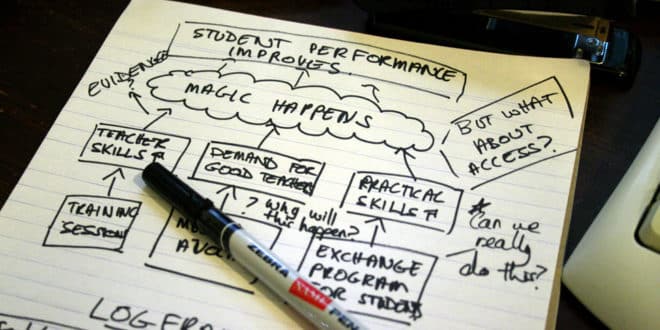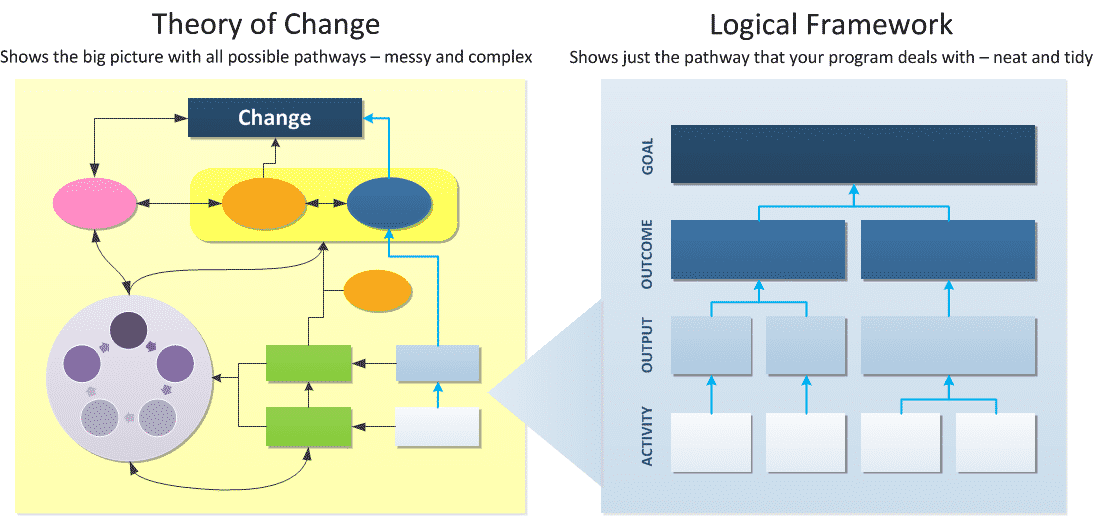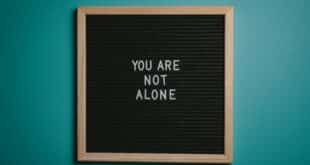Over the last few decades there has been an ongoing debate in the international development community about the best way to describe how programs lead to results. One approach has been to use a Logical Framework (also called a LogFrame), which most donors now require. Another increasingly popular approach is to create a Theory of Change.
In reality there is no official definition of a Theory of Change or how it differs from a Logical Framework. Both of them have the same general purpose – to describe how your program will lead to results, and to help you think critically about this. Some people even argue that a Theory of Change is essentially the same thing as a Logical Framework, it’s just that over time people have forgotten how to do Logical Frameworks properly.
So if the academics still can’t agree, how can you tell the difference?
Although academics are still debating the relationship between the two formats, in practice there are some differences in how they are used. At the simplest level, a Theory of Change shows the big, messy “real world” picture, with all the possible pathways leading to change, and why you think they lead to change (do you have evidence, or is it an assumption?).
A Logical Framework is like zooming in on the specific pathway that your program deals with and creating a neat, orderly structure for it. This makes it easier for you and the donor to monitor program implementation.
Theory of Change
In practice, a Theory of Change typically:
- Gives the big picture, including issues related to the environment or context that you can’t control.
- Shows all the different pathways that might lead to change, even if those pathways are not related to your program.
- Describes how and why you think change happens.
- Could be used to complete the sentence “if we do X then Y will change because…”.
- Is presented as a diagram with narrative text.
- The diagram is flexible and doesn’t have a particular format – it could include include cyclical processes, feedback loops, one box could lead to multiple other boxes, different shapes could be used, etc.
- Describes why you think one box will lead to another box (e.g. if you think increased knowledge will lead to behaviour change, is that an assumption or do you have evidence to show it is the case?).
- Is mainly used as a tool for program design and evaluation.
DFID have put together 10 examples of Theories of Change from their programs. You will see there is no standard format, although they all include a diagram and narrative text. Before each example is a check-list to assess whether the Theory of Change includes an analysis of the context, a clear hypotheses of change, and an assessment of the evidence (this is what DFID thinks they should include).
Logical Framework
In practice, a Logical Framework:
- Gives a detailed description of the program showing how the program activities will lead to the immediate outputs, and how these will lead to the outcomes and goal (the terminology used varies by organisation).
- Could be used to complete the sentence “we plan to do X which will give Y result”.
- Is normally shown as a matrix, called a logframe. It can also be shown as a flow chart, which is sometimes called a logic model.
- Is linear, which means that all activities lead to outputs which lead to outcomes and the goal – there are no cyclical processes or feedback loops.
- Includes space for risks and assumptions, although these are usually only basic. Doesn’t include evidence for why you think one thing will lead to another.
- Is mainly used as a tool for monitoring.
Need more help with logical frameworks?
Most Logical Frameworks are shown using a logframe matrix that is similar to this template, although organisations differ in the exact terminology used for the columns and rows.





